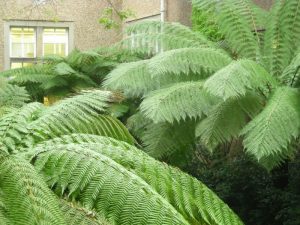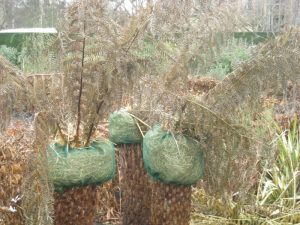Tree ferns lend a touch of the exotic and provide key architectural elements in the Queen Mothers Memorial Garden and alongside the Glasshouse ramp. Hailing from such diverse places as Australia and South Africa, these predominantly tender species may not survive our Scottish winters without protection and therefore, as a precaution, individual plants are wrapped in November before the onslaught of the winter chill.
The shortest day may have passed, but the middle of January is the coldest time of year for us. Our temperate maritime climate is moderated by the sea around the British Isles. The latent heat absorbed in the seas during the summer past has now lapsed and we are at the mercy of an icy chill approaching from the east.
It is a prolonged freezing spell that does the damage to tree ferns from the Southern Hemisphere, the odd night of frost will cause little if no damage.
To protect many of our tree ferns, straw is wrapped around the trunks, wired in place with netting. The crowns are especially vulnerable containing the growing point. These are protected with a handful of straw, topped with slates of polystyrene, in turn covered with a second layer of straw. The broken slates of polystyrene as well as insulating also deflect rain water from the crown.
Cyathea dregii, C. dealbata and C. smithii have been given this treatment. A fuller description may be found in the article ‘Winter Protection of Tree Ferns at the Royal Botanic Garden Edinburgh’ by Andrew Ensoll, L. Galloway and A. Wardlaw in Sibbaldia No 5, 2007.
You will note that the Dicksonia antarctica in the Queen Mother’s Memorial Garden have protection in the crown only. The trunk of many Dicksonia species are composed of a mass of intertwined roots increasing in girth annually. As the stem thickens with age, the central core receives more protection naturally. Young plants are the most vulnerable from prolonged freezing temperatures. The difference between the air temperature and the ground temperature is influential in their survival as the crown in a young plant is closer to the ground and will therefore experience lower temperatures.
This difference in temperature can be observed from the weather readings taken at the Garden. The grass minimum or ground temperature was recorded as low as -12.5ºC on a succession of days during December 2007 when the minimum air temperature was recorded as -6ºC. That is 6ºC lower at ground level on a succession of days.
Fronds are blackened and damaged when the air temperature falls below -4.7ºC. This is evident in the image of the blackened fronds in the Queen Mother’s Memorial Garden.
A group of ferns are established in a sheltered quadrangle within the Balfour building complex at the Garden. Within this area these freezing temperatures were not recorded. The difference in appearance of the fronds can be seen in the attached images, both taken on 28 December 2007 following five days with freezing temperature of -4º c or less recorded.


